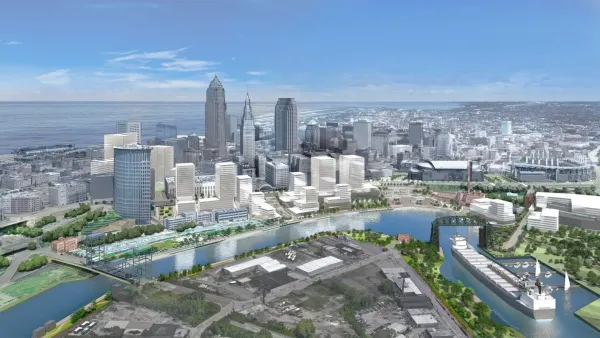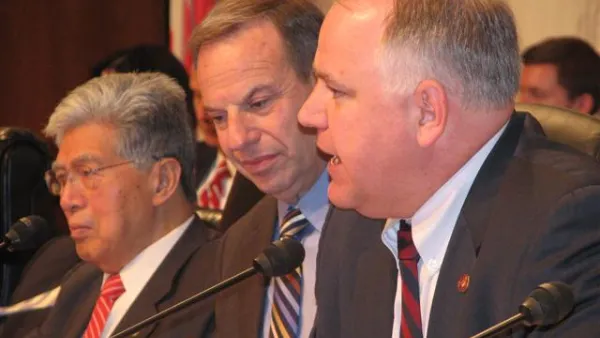It's certainly not a new idea - what's new is the current bipartisan Senate bill, cutely abbreviated as the BRIDGE Act, seeded with $10 billion of federal funds that would attract funds from the private sector to be loaned to worthy projects.
Proposed by Sens. Mark Warner (D-Va.) and Roy Blunt (R-Mo.) on Nov. 14, the Building and Renewing Infrastructure for Development and Growth in Employment (BRIDGE) Act [PDF-fact sheet] would create a $300 billion national infrastructure funding bank, writes Keith Laing.
Already the bill has drawn support from both sides of the political aisle as the press release from Sen. Dean Heller (R-Nev.) indicates.
The BRIDGE Act, introduced by lead sponsors Sens. Mark R. Warner (D-VA) and Roy Blunt (R-MO), is cosponsored by Lindsey Graham (R-SC), Kirsten Gillibrand (D-NY), Dean Heller (R-NV), Chris Coons (D-DE), Amy Klobuchar (D-MN), Roger Wicker (R-MS), Claire McCaskill (D-MO) and Mark Kirk (R-IL).
So, how to convert that $10 billion in seed funding to $300 billion? According to a statement by Sen. Warner, "this proposal creates smart new tools to help our states and localities unlock billions of dollars in additional private investments at a time of very favorable interest rates."
Laing clarifies (or further mystifies) by explaining that "(t)he infrastructure funding would be used as leverage to lure private sector investments that could reap as much as $300 billion in new transportation projects, according to Warner's office."
Laing references a 2011 bipartisan senate bill that attempted the same goal. "The Kerry-Hutchinson proposal called for created a $50 billion infrastructure bank, but the legislation ran into opposition from Republicans in the House who said they would prefer to let states establish their own infrastructure banks."
While Laing doesn't indicate if that reception would change with the current bill, it's worth noting that the prior proposal was attempted before the current surface transportation legislation, known as MAP-21, passed in July, 2012.
A review of the numerous articles on this topic posted here and here found this explanation by Robert Puentes, a scholar at the Brookings Institution, on how the bank works, why the private sector would invest in it, and why the Kerry-Hutchinson bill was attracting serious attention.
"The real reason it's getting so much attention now is that it's mistakenly framed as free money, as something that, if we can't raise money other ways, if we can't raise the gas tax, can't tap general funds, let's do an infrastructure bank — that's a good idea!" Puentes states in Pacific Standard on March 24, 2011. Emily Badger further describes how the low interest loans and selective projects based on merit, not politics, would attract private funding:
But it's to help those projects that need some kind of complex funding packages put together, that have public-private partnership components — projects that are almost guaranteed to have a return on investment, as opposed to projects that have questionable merit.
FULL STORY: Senate bill revives infrastructure bank idea

Analysis: Cybertruck Fatality Rate Far Exceeds That of Ford Pinto
The Tesla Cybertruck was recalled seven times last year.

National Parks Layoffs Will Cause Communities to Lose Billions
Thousands of essential park workers were laid off this week, just before the busy spring break season.

Retro-silient?: America’s First “Eco-burb,” The Woodlands Turns 50
A master-planned community north of Houston offers lessons on green infrastructure and resilient design, but falls short of its founder’s lofty affordability and walkability goals.

Test News Post 1
This is a summary

Analysis: Cybertruck Fatality Rate Far Exceeds That of Ford Pinto
The Tesla Cybertruck was recalled seven times last year.

Test News Headline 46
Test for the image on the front page.
Urban Design for Planners 1: Software Tools
This six-course series explores essential urban design concepts using open source software and equips planners with the tools they need to participate fully in the urban design process.
Planning for Universal Design
Learn the tools for implementing Universal Design in planning regulations.
EMC Planning Group, Inc.
Planetizen
Planetizen
Mpact (formerly Rail~Volution)
Great Falls Development Authority, Inc.
HUDs Office of Policy Development and Research
NYU Wagner Graduate School of Public Service



























